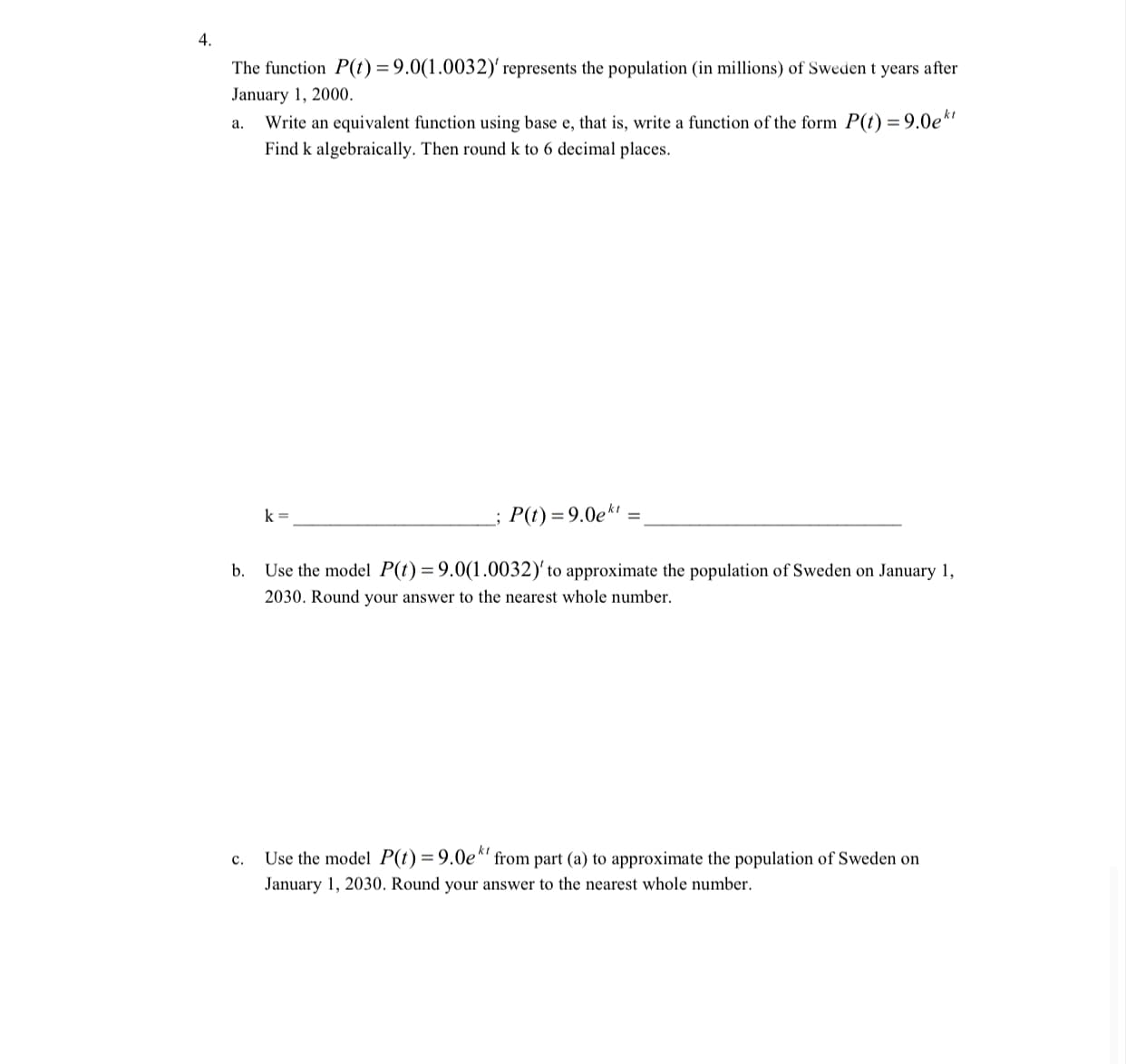4. The function P(t) = 9.0(1.0032)' represents the population (in millions) of Sweden t years after January 1, 2000. Write an equivalent function using base e, that is, write a function of the form P(t) = 9.0e*" a. Find k algebraically. Then round k to 6 decimal places. k = ; P(t) = 9.0e*" b. Use the model P(t) = 9.0(1.0032)' to approximate the population of Sweden on January 1, 2030. Round your answer to the nearest whole number. Use the model P(t) = 9.0e*' from part (a) to approximate the population of Sweden on c. January 1, 2030. Round your answer to the nearest whole number.
4. The function P(t) = 9.0(1.0032)' represents the population (in millions) of Sweden t years after January 1, 2000. Write an equivalent function using base e, that is, write a function of the form P(t) = 9.0e*" a. Find k algebraically. Then round k to 6 decimal places. k = ; P(t) = 9.0e*" b. Use the model P(t) = 9.0(1.0032)' to approximate the population of Sweden on January 1, 2030. Round your answer to the nearest whole number. Use the model P(t) = 9.0e*' from part (a) to approximate the population of Sweden on c. January 1, 2030. Round your answer to the nearest whole number.
Chapter6: Exponential And Logarithmic Functions
Section6.1: Exponential Functions
Problem 60SE: The formula for the amount A in an investmentaccount with a nominal interest rate r at any timet is...
Related questions
Concept explainers
Contingency Table
A contingency table can be defined as the visual representation of the relationship between two or more categorical variables that can be evaluated and registered. It is a categorical version of the scatterplot, which is used to investigate the linear relationship between two variables. A contingency table is indeed a type of frequency distribution table that displays two variables at the same time.
Binomial Distribution
Binomial is an algebraic expression of the sum or the difference of two terms. Before knowing about binomial distribution, we must know about the binomial theorem.
Topic Video
Question
4c.

Transcribed Image Text:4.
The function P(t) = 9.0(1.0032)' represents the population (in millions) of Sweden t years after
January 1, 2000.
Write an equivalent function using base e, that is, write a function of the form P(t) = 9.0e*"
a.
Find k algebraically. Then round k to 6 decimal places.
k =
; P(t) = 9.0e*"
b.
Use the model P(t) = 9.0(1.0032)' to approximate the population of Sweden on January 1,
2030. Round your answer to the nearest whole number.
Use the model P(t) = 9.0e*' from part (a) to approximate the population of Sweden on
c.
January 1, 2030. Round your answer to the nearest whole number.
Expert Solution
This question has been solved!
Explore an expertly crafted, step-by-step solution for a thorough understanding of key concepts.
This is a popular solution!
Trending now
This is a popular solution!
Step by step
Solved in 2 steps with 3 images

Knowledge Booster
Learn more about
Need a deep-dive on the concept behind this application? Look no further. Learn more about this topic, algebra and related others by exploring similar questions and additional content below.Recommended textbooks for you


College Algebra
Algebra
ISBN:
9781305115545
Author:
James Stewart, Lothar Redlin, Saleem Watson
Publisher:
Cengage Learning

Algebra & Trigonometry with Analytic Geometry
Algebra
ISBN:
9781133382119
Author:
Swokowski
Publisher:
Cengage


College Algebra
Algebra
ISBN:
9781305115545
Author:
James Stewart, Lothar Redlin, Saleem Watson
Publisher:
Cengage Learning

Algebra & Trigonometry with Analytic Geometry
Algebra
ISBN:
9781133382119
Author:
Swokowski
Publisher:
Cengage